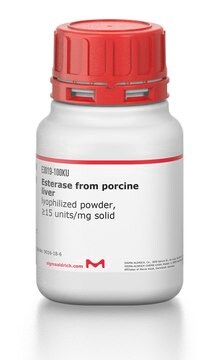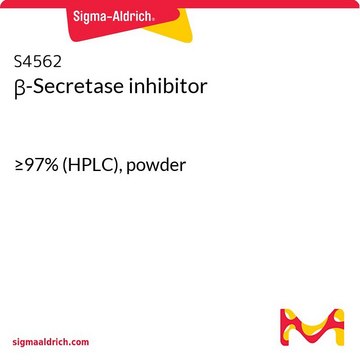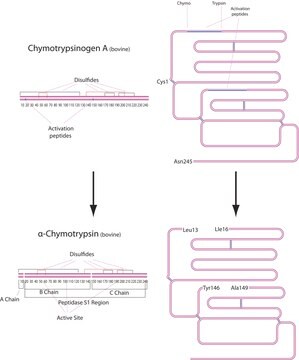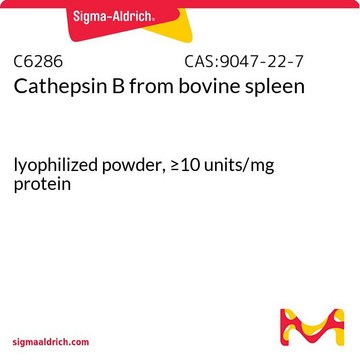C8118
Chymase human
recombinant, expressed in Pichia pastoris
Synonym(s):
Mast cell protease I
Sign Into View Organizational & Contract Pricing
All Photos(2)
About This Item
CAS Number:
MDL number:
UNSPSC Code:
12352204
NACRES:
NA.54
Recommended Products
recombinant
expressed in Pichia pastoris
Quality Level
form
liquid
specific activity
≥40 units/mg protein
mol wt
~37 kDa by SDS-PAGE
concentration
125-400 μg/mL
UniProt accession no.
application(s)
diagnostic assay manufacturing
shipped in
dry ice
storage temp.
−20°C
Gene Information
human ... CMA1(1215)
Looking for similar products? Visit Product Comparison Guide
Related Categories
Application
Human chymase has been used in a study to assess the effects of Panax notoginseng flower extract on the TGF-β/Smad signal transduction pathway in heart remodeling. Human chymase has also been used in a study to investigate the blood glucose level and survival in streptozotocin-treated human chymase transgenic mice.
Chymase has been implicated in generation of angiotensin II and cleavage of big endothelin. Studies indicate it may be involved in vascular proliferation, myocardial infarction and dermatitis.
Biochem/physiol Actions
The enzyme rapidly converts angiotensin I to angiotensin II. Optimum pH for the enzyme activity is between 7.5 and 9.0. Enzyme activity is inhibited by soybean trypsin inhibitor, phenylmethylsulfonyl fluoride and chymostatin.
Physical properties
Chymase is a cathepsin G-like, S1 serine proteinase found primarily in mast cells. It has a molecular mass of ~30 kDa, however its apparent molecular mass on SDS-PAGE is around 37 kDa.
Unit Definition
One unit hydrolyzes one micromole of N-benzoyl-L-tyrosine ethyl ester (BTEE) per minute at pH 7.8 and 25 °C. The assay buffer used to determine the enzyme activity contains 27 mM Tris-HCl, pH 7.8, with 150 mM NaCl and 0.43 mM BTEE.
Physical form
Supplied as a solution in 20 mM Tris, 0.8 M NaCl and 25% glycerol, pH 7.6
Storage Class Code
10 - Combustible liquids
WGK
WGK 1
Flash Point(F)
Not applicable
Flash Point(C)
Not applicable
Personal Protective Equipment
dust mask type N95 (US), Eyeshields, Gloves
Choose from one of the most recent versions:
Already Own This Product?
Find documentation for the products that you have recently purchased in the Document Library.
Ananya Roy et al.
The Journal of biological chemistry, 289(1), 237-250 (2013-11-22)
During infection and tissue damage, virulence factors and alarmins are pro-inflammatory and induce activation of various immune cells including macrophages and mast cells (MCs). Activated MCs instantly release preformed inflammatory mediators, including several proteases. The chymase mouse mast cell protease
Devandir Antonio de Souza et al.
PloS one, 7(7), e40790-e40790 (2012-07-21)
Tumor cells are surrounded by infiltrating inflammatory cells, such as lymphocytes, neutrophils, macrophages, and mast cells. A body of evidence indicates that mast cells are associated with various types of tumors. Although role of mast cells can be directly related
Jacco J de Haan et al.
American journal of physiology. Gastrointestinal and liver physiology, 305(5), G383-G391 (2013-07-03)
Nutritional stimulation of the cholecystokinin-1 receptor (CCK-1R) and nicotinic acetylcholine receptor (nAChR)-mediated vagal reflex was shown to reduce inflammation and preserve intestinal integrity. Mast cells are important early effectors of the innate immune response; therefore modulation of mucosal mast cells
S Takai et al.
Clinica chimica acta; international journal of clinical chemistry, 265(1), 13-20 (1997-11-14)
A chymostatin-sensitive angiotensin II-generating enzyme was found in human gastroepiploic arteries. The enzyme was purified using heparin affinity and gel filtration columns. The molecular mass of the purified enzyme was 30 kDa, and the optimum pH was between 7.5 and
Su Duy Nguyen et al.
Journal of lipid research, 53(10), 2115-2125 (2012-08-03)
HDL particles may enter atherosclerotic lesions having an acidic intimal fluid. Therefore, we investigated whether acidic pH would affect their structural and functional properties. For this purpose, HDL(2) and HDL(3) subfractions were incubated for various periods of time at different
Our team of scientists has experience in all areas of research including Life Science, Material Science, Chemical Synthesis, Chromatography, Analytical and many others.
Contact Technical Service







